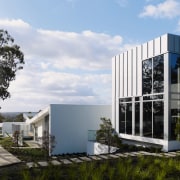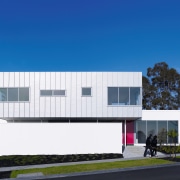Fitted like a jigsaw
A series of new townhouses has been designed to integrate with the surrounding landscape and to respect each home's privacy and access to sun and light
Designing a series of homes for a new subdivision creates an opportunity to consider the architectural integrity of the entire local community, rather than simply focusing on providing the best possible features for an individual house.
The architect, dKO Architecture, was asked to develop a plan to build a number of houses on the site of the historic Kew Children's Cottages. This now-decommissioned special development school and residential service first opened in 1887 for children and adults with intellectual disabilities, and the redeveloped site retains several of the old buildings.
Principal architect for the project Koos de Keijzer says the site was very special, partly because of its historical associations and also because of the opportunities provided by the existing full-grown trees and lush vegetation.
"As well as the usual town-planning considerations, our design for Main Street Kew had to meet Victoria's Department of Human Services policy guidelines. This meant we had to provide 20 community houses that would integrate seamlessly into the local community. These had to be big, hostel-type houses with five or six bedrooms for patients and carers," he says.
The site also includes three heritage-listed cottages that will ultimately be renovated and incorporated into the community.
Fifty-five homes and 20 hostels have been designed and built over a sloping 28ha site as part of the first stage of the development. Eventually, Kew Drive will have a total of 280 homes and 150 apartments, which will be in small blocks of six units. There will also be recreational facilities for residents in a precinct built round the three heritage cottages.
"Each site and the house on it has been macroplanned so that what happens next door does not affect anyone else. Pulling this development together was rather like doing a jigsaw. We looked at the whole site to work out the best placement for each house, bearing in mind factors such as the slope of the land, the solar ingress and the likely location of neighbouring houses, then subdivided the land based on these considerations."
Homes in the development are in a range of styles and designs, placed in different combinations to create a vibrant streetscape.
De Keijzer describes this concept as an integrated housing community, because each house is designed in conjunction with the one next door, rather than planned in isolation.
"The architecture of the houses is very modern; we chose natural materials where possible, and a predominantly white colour scheme. The existing vegetation and blue sky provide a naturally good architectural form, so there was no need for a lot of colour or design complexity. The stark, white finishes stand out against the landscape, the gum trees and the sky, and by using only two or three elements, we have a balanced composition," says de Keijzer.
"Colour would have introduced a level of complexity the site did not need."
Houses are finished in natural blockwork with zinc to articulate the corners, and the different designs take account of the particular features of each individual site, such as the slope of the land and existing trees. Most glazing is on the north- and west-facing sides to capture sun, while fewer windows on the southern walls minimise heat loss.
"Terraces and open spaces are private and not overlooked by neighbours," says de Keijzer.
The old hospital had its entrance at the beginning of Main Drive, and this has been reused as the entry point for the development. The road through the hospital is now the civic spine of the neighbourhood.
To preserve and enhance the existing vegetation, and to blur the line between roads and open spaces, most of the streets are not kerbed.
Access to parks and open spaces another feature of Main Street Kew had to meet the needs of the inhabitants of the hostels, some of whom are access-impaired. As a result, footpaths follow a gentle, zigzagging course that has a gradient rating of not more than one in fourteen.
Sustainability was also an aspect of the design, so parks are irrigated using recycled water that has been collected from the site and stored in underground catchment ponds.
Credit list
Architect
Project designer
Construction and quantity surveyor
Landscaping
Roofing
Hardware
Story by: Mary Webb
Home kitchen bathroom commercial design
Colourful and casual
Underpinning the artistic
Connected to the ocean












